Đặc trưng ngữ nghĩa dựa vào sự đoán định của những kết ngôn giữa động từ phi thực hữu tri nhận và phó từ tình thái nhận thức
Tình thái từ lâu đã là một lĩnh vực khá hấp dẫn với hầu hết các nhà ngôn ngữ học trên thế giới do bởi tính phức tạp và đa dạng của nó. Các phương tiện để diễn đạt tình thái bao gồm động từ, tính từ, phó từ, tiểu từ. đặc biệt hơn cả là các kết ngôn giữa hai phương tiện từ vựng: động từ phi thực hữu tri nhận và phó từ tình thái. Các kết ngôn tình thái này không nhằm mục đích thông báo hành động của chủ ngữ mà cho biết thái độ và sự đoán định của người nói với khả năng hiện thực của sự tình được nêu ở mệnh đề. Do đó, để hiểu và sử dụng các kết ngôn tình thái này có hiệu quả trong giao tiếp, người ta cần nắm rõ những đặc điểm ngôn ngữ của chúng. Dựa vào hơn 700 phát ngôn tiếng Anh được thu thập từ tiếu thuyết, truyện ngắn và trên mạng internet, bài viết này phân tích những đặc trưng ngữ nghĩa của các kết ngôn tình thái dựa vào sự đoán định nhằm giúp người học tiếng Anh hoặc thậm chí là những người Anh bản xứ nâng cao khả năng giao tiếp tiếng Anh cũng như sử dụng chuẩn xác các kết ngôn tình thái này trong việc kiến tạo các phát ngôn bằng tiếng Anh. Đồng thời, kết quả khảo sát trong bài cũng có thể giúp ích trong việc giảng dạy tiếng Anh như một ngoại ngữ
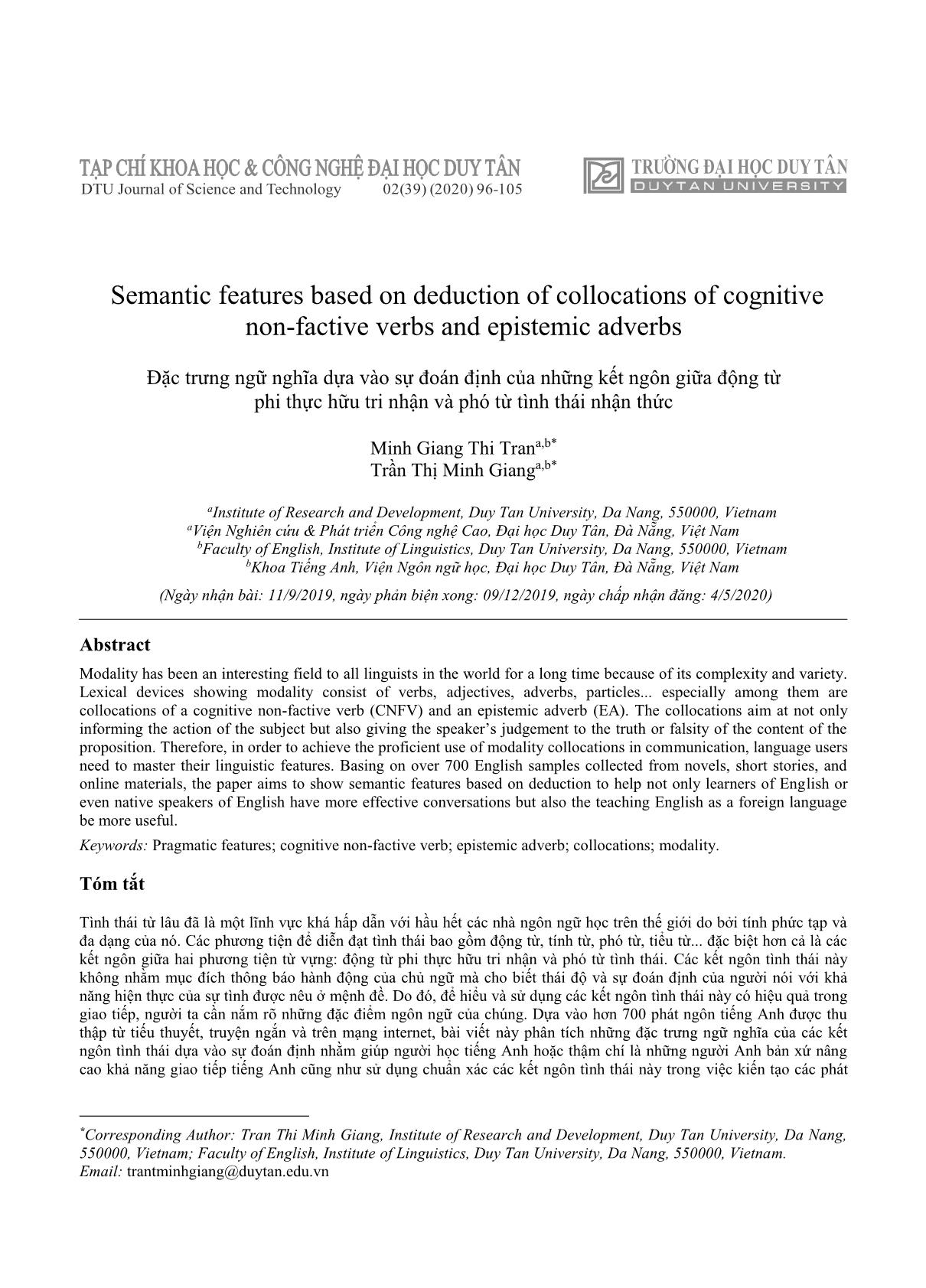
Trang 1
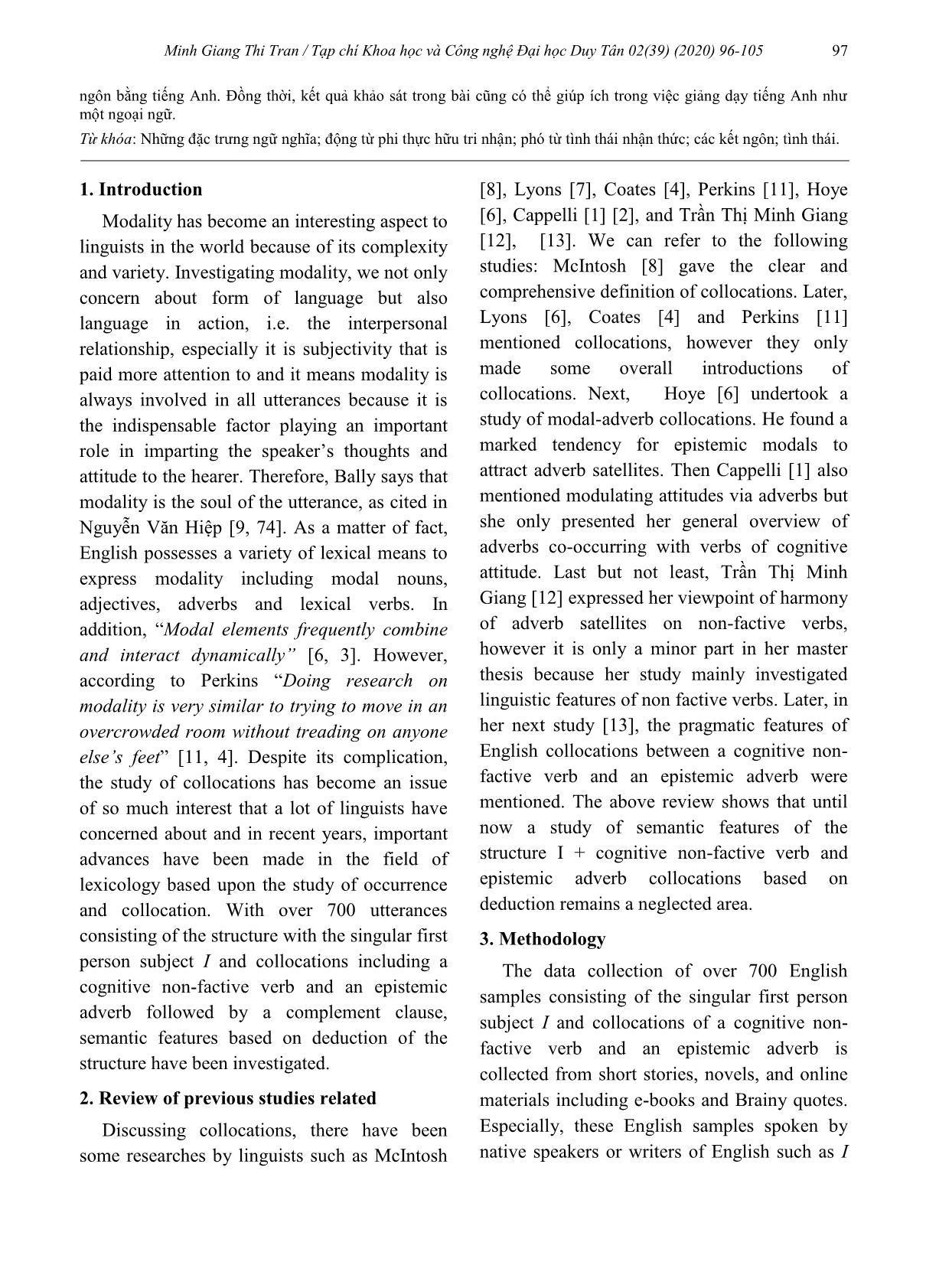
Trang 2
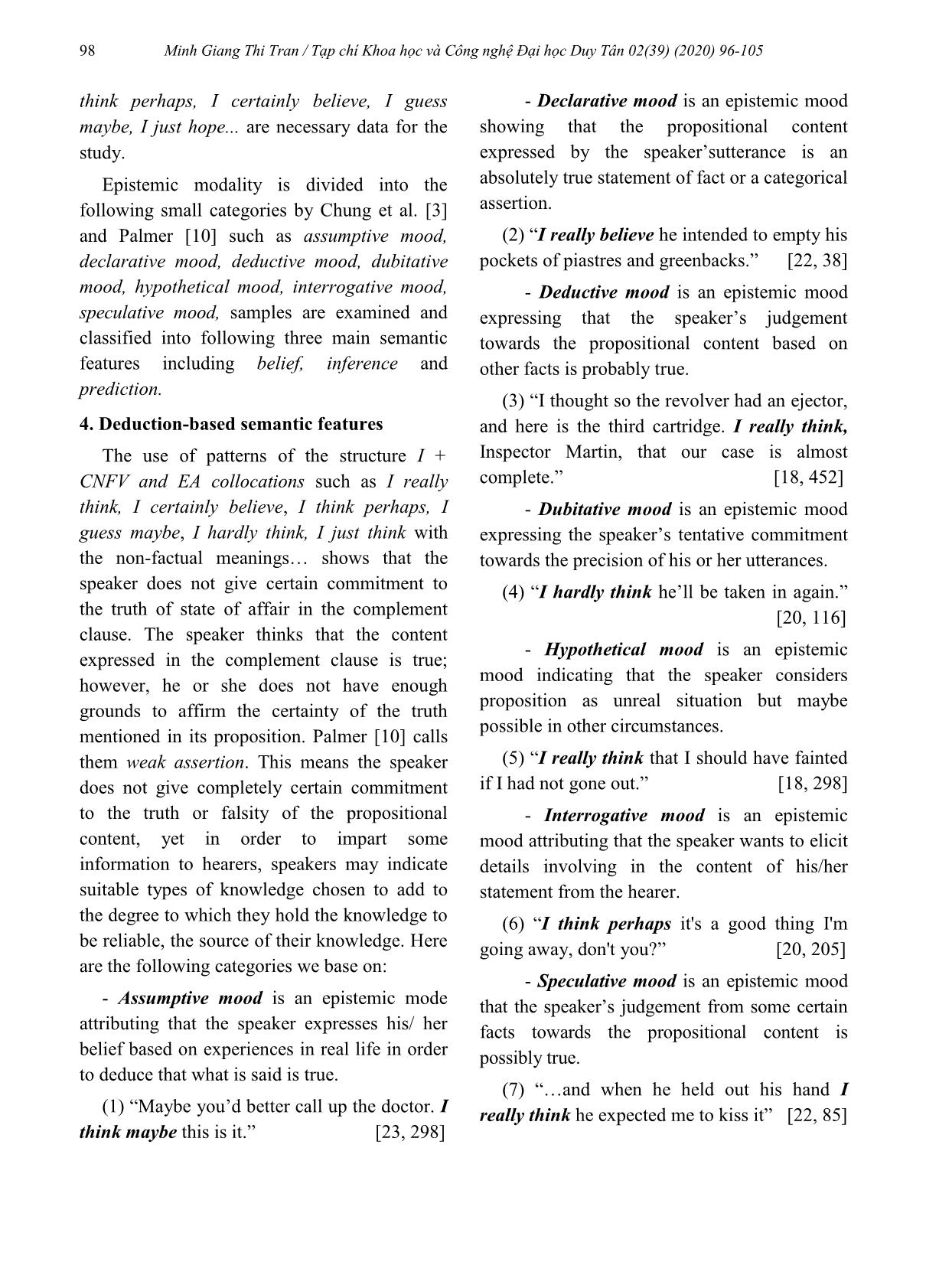
Trang 3

Trang 4
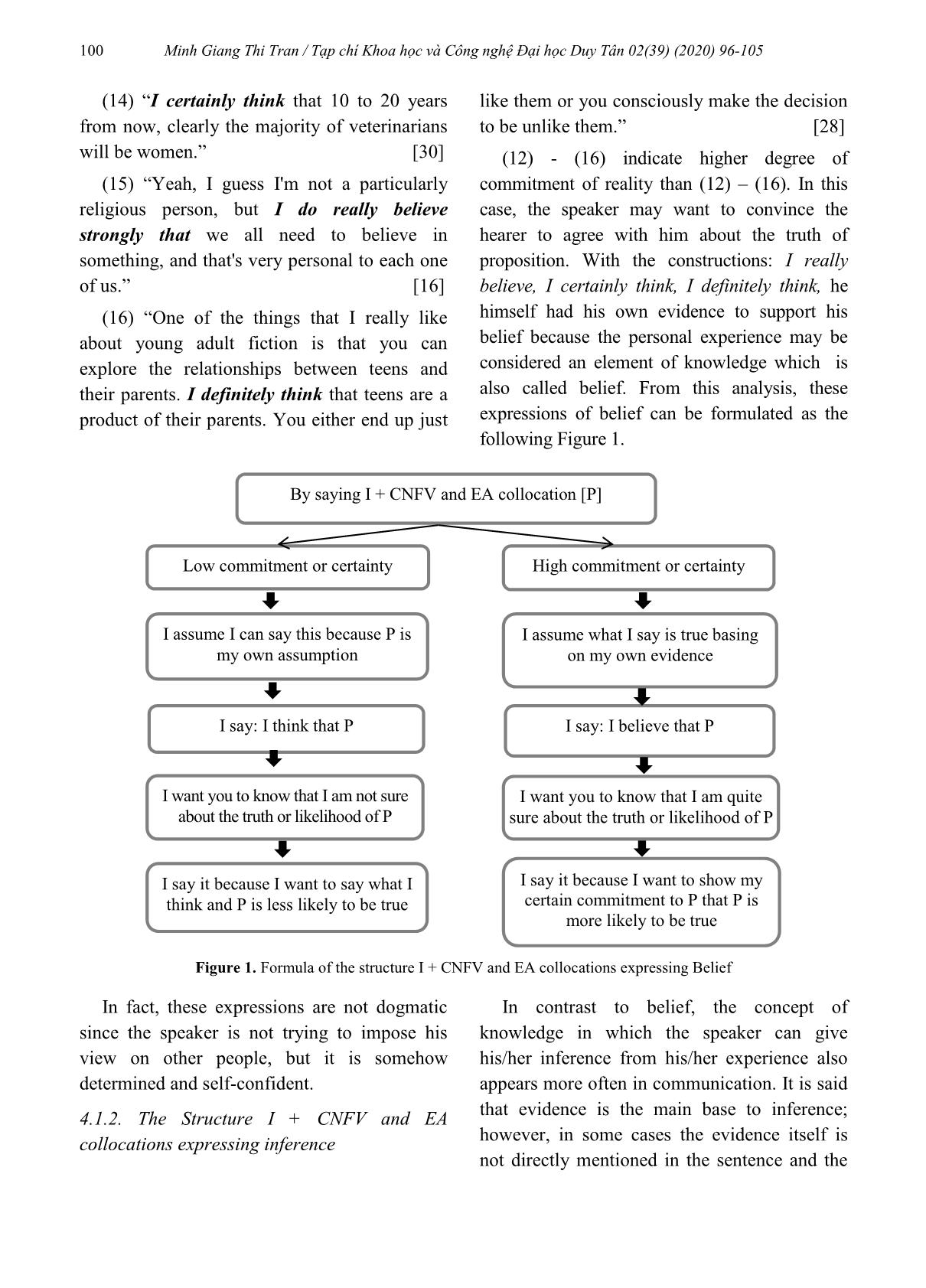
Trang 5
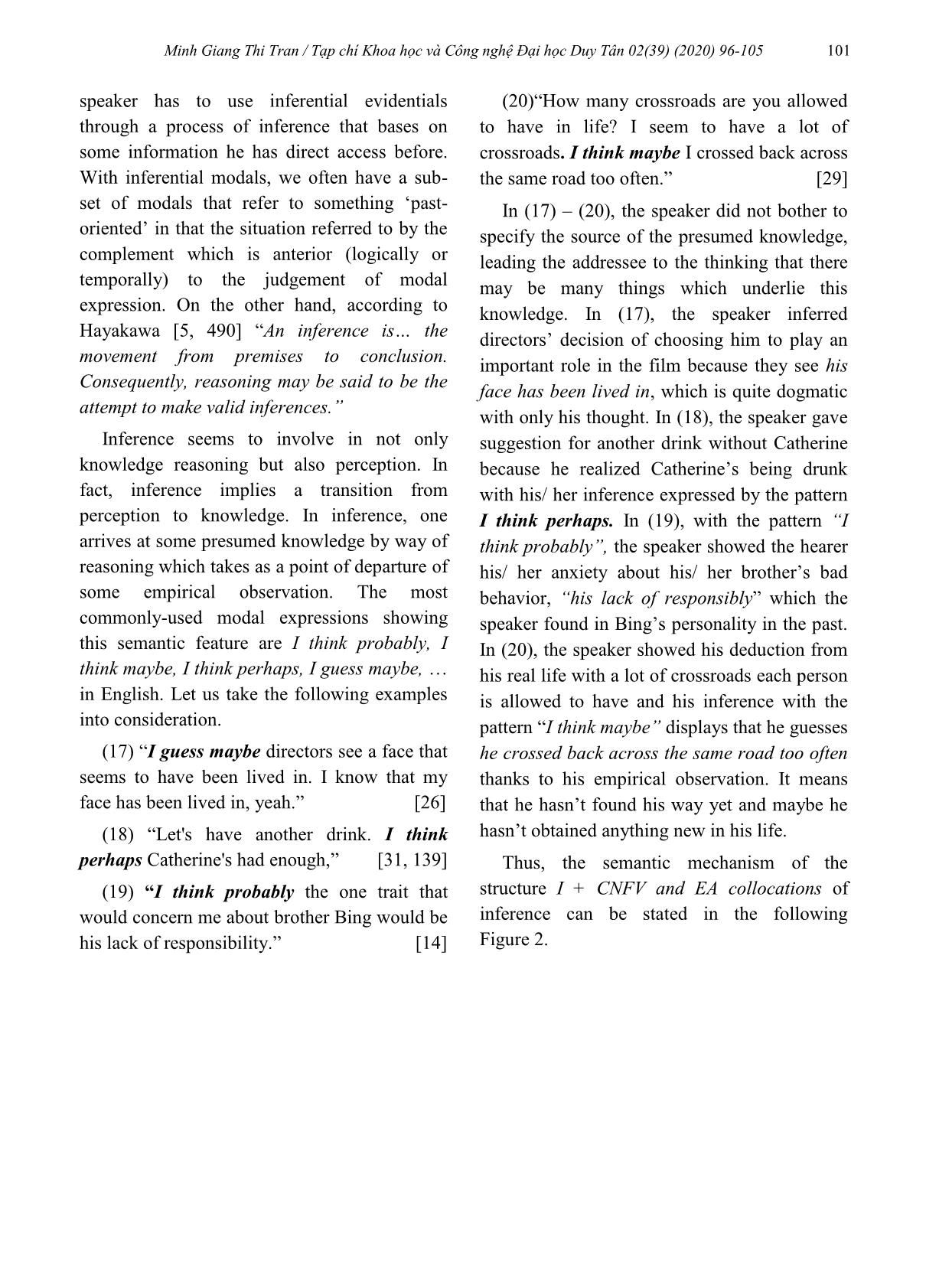
Trang 6
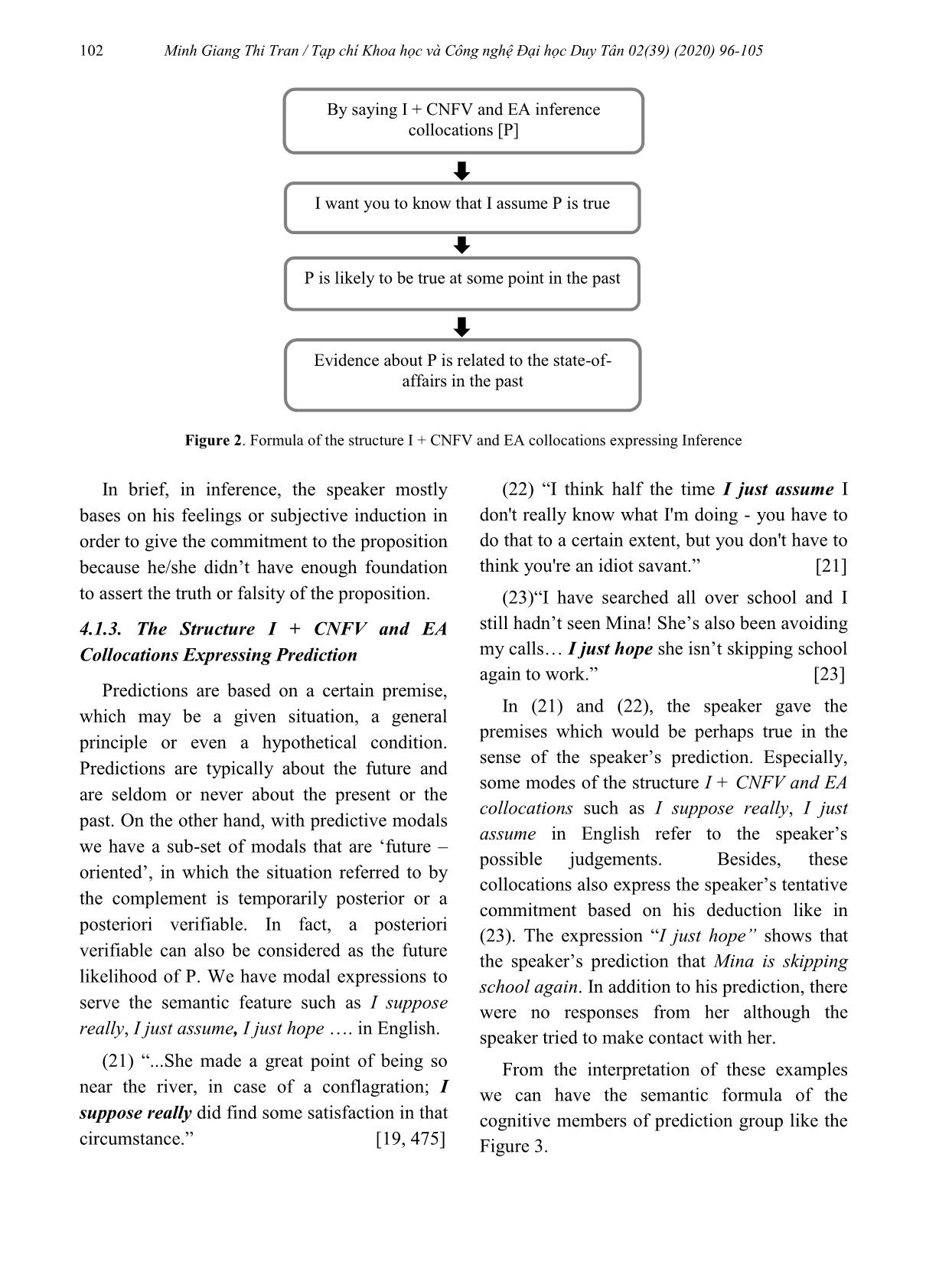
Trang 7
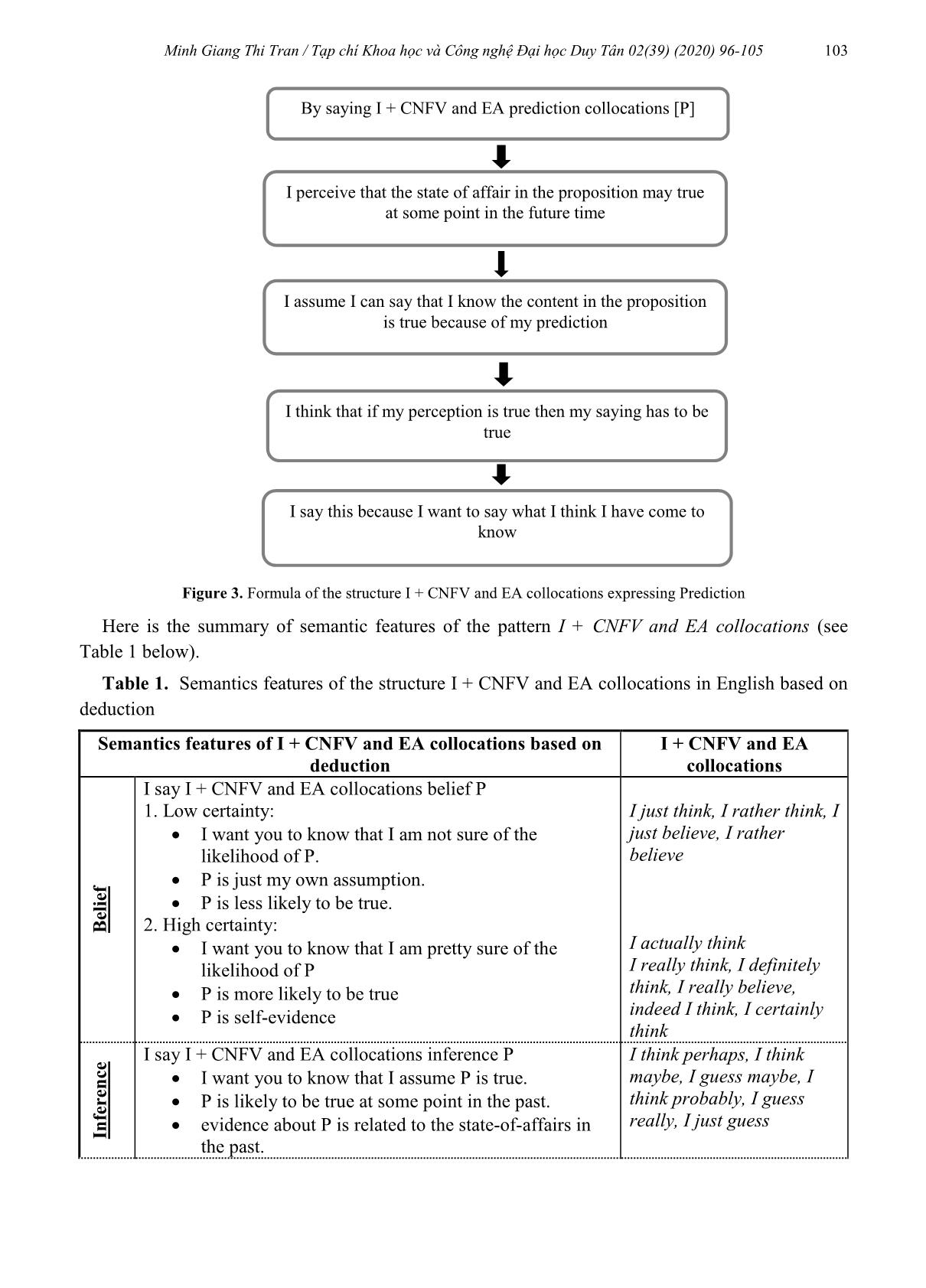
Trang 8
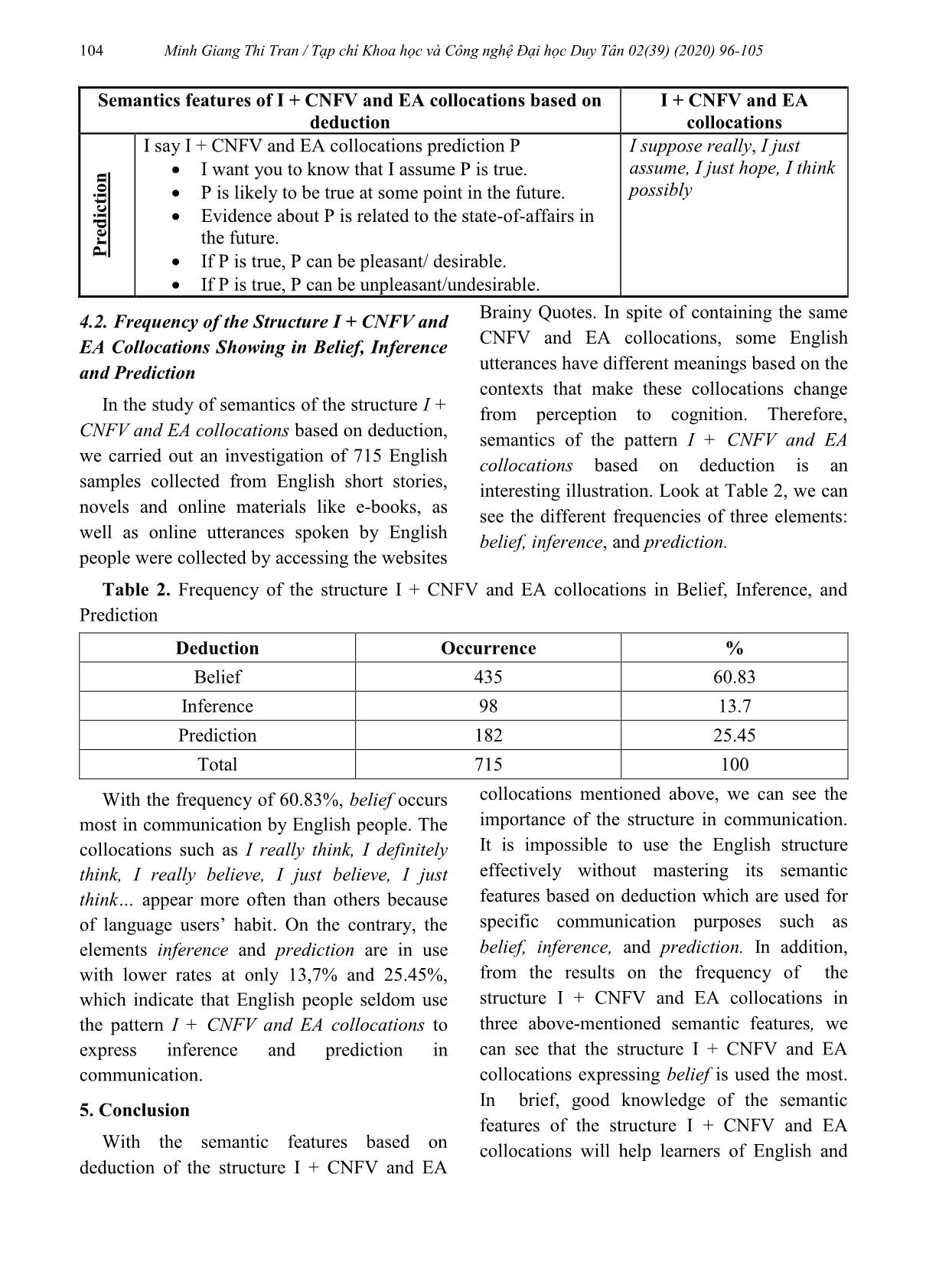
Trang 9
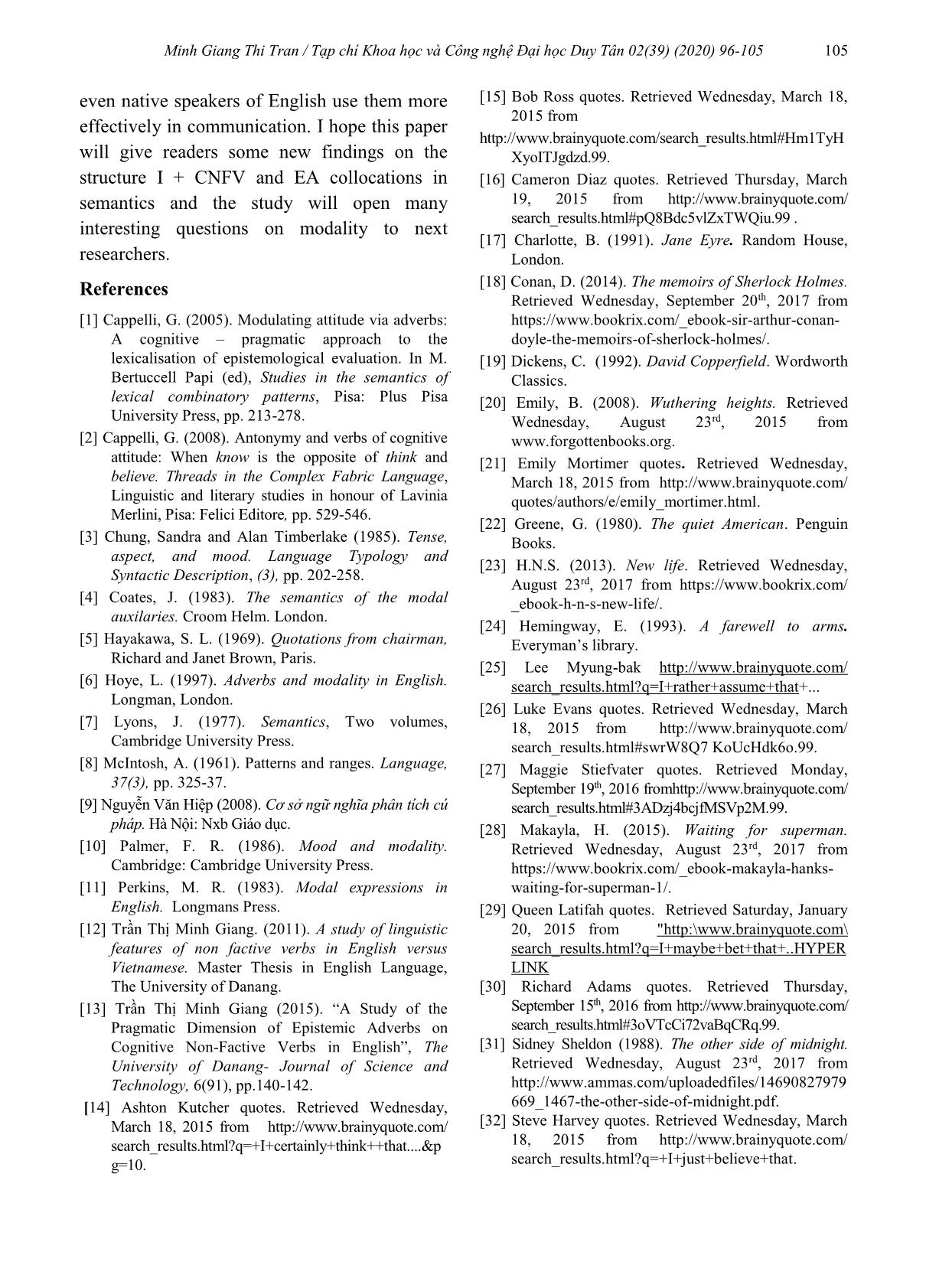
Trang 10
Tóm tắt nội dung tài liệu: Đặc trưng ngữ nghĩa dựa vào sự đoán định của những kết ngôn giữa động từ phi thực hữu tri nhận và phó từ tình thái nhận thức
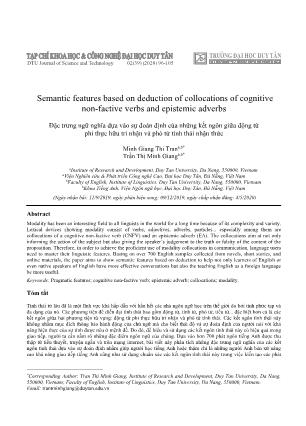
I am quite sure about the truth or likelihood of P Minh Giang Thi Tran / Tạp chí Khoa học và Công nghệ Đại học Duy Tân 02(39) (2020) 96-105 101 speaker has to use inferential evidentials through a process of inference that bases on some information he has direct access before. With inferential modals, we often have a sub- set of modals that refer to something ‘past- oriented’ in that the situation referred to by the complement which is anterior (logically or temporally) to the judgement of modal expression. On the other hand, according to Hayakawa [5, 490] “An inference is the movement from premises to conclusion. Consequently, reasoning may be said to be the attempt to make valid inferences.” Inference seems to involve in not only knowledge reasoning but also perception. In fact, inference implies a transition from perception to knowledge. In inference, one arrives at some presumed knowledge by way of reasoning which takes as a point of departure of some empirical observation. The most commonly-used modal expressions showing this semantic feature are I think probably, I think maybe, I think perhaps, I guess maybe, in English. Let us take the following examples into consideration. (17) “I guess maybe directors see a face that seems to have been lived in. I know that my face has been lived in, yeah.” [26] (18) “Let's have another drink. I think perhaps Catherine's had enough,” [31, 139] (19) “I think probably the one trait that would concern me about brother Bing would be his lack of responsibility.” [14] (20)“How many crossroads are you allowed to have in life? I seem to have a lot of crossroads. I think maybe I crossed back across the same road too often.” [29] In (17) – (20), the speaker did not bother to specify the source of the presumed knowledge, leading the addressee to the thinking that there may be many things which underlie this knowledge. In (17), the speaker inferred directors’ decision of choosing him to play an important role in the film because they see his face has been lived in, which is quite dogmatic with only his thought. In (18), the speaker gave suggestion for another drink without Catherine because he realized Catherine’s being drunk with his/ her inference expressed by the pattern I think perhaps. In (19), with the pattern “I think probably”, the speaker showed the hearer his/ her anxiety about his/ her brother’s bad behavior, “his lack of responsibly” which the speaker found in Bing’s personality in the past. In (20), the speaker showed his deduction from his real life with a lot of crossroads each person is allowed to have and his inference with the pattern “I think maybe” displays that he guesses he crossed back across the same road too often thanks to his empirical observation. It means that he hasn’t found his way yet and maybe he hasn’t obtained anything new in his life. Thus, the semantic mechanism of the structure I + CNFV and EA collocations of inference can be stated in the following Figure 2. Minh Giang Thi Tran / Tạp chí Khoa học và Công nghệ Đại học Duy Tân 02(39) (2020) 96-105 102 Figure 2. Formula of the structure I + CNFV and EA collocations expressing Inference In brief, in inference, the speaker mostly bases on his feelings or subjective induction in order to give the commitment to the proposition because he/she didn’t have enough foundation to assert the truth or falsity of the proposition. 4.1.3. The Structure I + CNFV and EA Collocations Expressing Prediction Predictions are based on a certain premise, which may be a given situation, a general principle or even a hypothetical condition. Predictions are typically about the future and are seldom or never about the present or the past. On the other hand, with predictive modals we have a sub-set of modals that are ‘future – oriented’, in which the situation referred to by the complement is temporarily posterior or a posteriori verifiable. In fact, a posteriori verifiable can also be considered as the future likelihood of P. We have modal expressions to serve the semantic feature such as I suppose really, I just assume, I just hope . in English. (21) “...She made a great point of being so near the river, in case of a conflagration; I suppose really did find some satisfaction in that circumstance.” [19, 475] (22) “I think half the time I just assume I don't really know what I'm doing - you have to do that to a certain extent, but you don't have to think you're an idiot savant.” [21] (23)“I have searched all over school and I still hadn’t seen Mina! She’s also been avoiding my calls I just hope she isn’t skipping school again to work.” [23] In (21) and (22), the speaker gave the premises which would be perhaps true in the sense of the speaker’s prediction. Especially, some modes of the structure I + CNFV and EA collocations such as I suppose really, I just assume in English refer to the speaker’s possible judgements. Besides, these collocations also express the speaker’s tentative commitment based on his deduction like in (23). The expression “I just hope” shows that the speaker’s prediction that Mina is skipping school again. In addition to his prediction, there were no responses from her although the speaker tried to make contact with her. From the interpretation of these examples we can have the semantic formula of the cognitive members of prediction group like the Figure 3. By saying I + CNFV and EA inference collocations [P] I want you to know that I assume P is true P is likely to be true at some point in the past Evidence about P is related to the state-of- affairs in the past Minh Giang Thi Tran / Tạp chí Khoa học và Công nghệ Đại học Duy Tân 02(39) (2020) 96-105 103 Figure 3. Formula of the structure I + CNFV and EA collocations expressing Prediction Here is the summary of semantic features of the pattern I + CNFV and EA collocations (see Table 1 below). Table 1. Semantics features of the structure I + CNFV and EA collocations in English based on deduction Semantics features of I + CNFV and EA collocations based on deduction I + CNFV and EA collocations B el ie f I say I + CNFV and EA collocations belief P 1. Low certainty: I want you to know that I am not sure of the likelihood of P. P is just my own assumption. P is less likely to be true. 2. High certainty: I want you to know that I am pretty sure of the likelihood of P P is more likely to be true P is self-evidence I just think, I rather think, I just believe, I rather believe I actually think I really think, I definitely think, I really believe, indeed I think, I certainly think In fe re n ce I say I + CNFV and EA collocations inference P I want you to know that I assume P is true. P is likely to be true at some point in the past. evidence about P is related to the state-of-affairs in the past. I think perhaps, I think maybe, I guess maybe, I think probably, I guess really, I just guess By saying I + CNFV and EA prediction collocations [P] I perceive that the state of affair in the proposition may true at some point in the future time I think that if my perception is true then my saying has to be true I assume I can say that I know the content in the proposition is true because of my prediction I say this because I want to say what I think I have come to know Minh Giang Thi Tran / Tạp chí Khoa học và Công nghệ Đại học Duy Tân 02(39) (2020) 96-105 104 Semantics features of I + CNFV and EA collocations based on deduction I + CNFV and EA collocations P re d ic ti o n I say I + CNFV and EA collocations prediction P I want you to know that I assume P is true. P is likely to be true at some point in the future. Evidence about P is related to the state-of-affairs in the future. If P is true, P can be pleasant/ desirable. If P is true, P can be unpleasant/undesirable. I suppose really, I just assume, I just hope, I think possibly 4.2. Frequency of the Structure I + CNFV and EA Collocations Showing in Belief, Inference and Prediction In the study of semantics of the structure I + CNFV and EA collocations based on deduction, we carried out an investigation of 715 English samples collected from English short stories, novels and online materials like e-books, as well as online utterances spoken by English people were collected by accessing the websites Brainy Quotes. In spite of containing the same CNFV and EA collocations, some English utterances have different meanings based on the contexts that make these collocations change from perception to cognition. Therefore, semantics of the pattern I + CNFV and EA collocations based on deduction is an interesting illustration. Look at Table 2, we can see the different frequencies of three elements: belief, inference, and prediction. Table 2. Frequency of the structure I + CNFV and EA collocations in Belief, Inference, and Prediction Deduction Occurrence % Belief 435 60.83 Inference 98 13.7 Prediction 182 25.45 Total 715 100 With the frequency of 60.83%, belief occurs most in communication by English people. The collocations such as I really think, I definitely think, I really believe, I just believe, I just think appear more often than others because of language users’ habit. On the contrary, the elements inference and prediction are in use with lower rates at only 13,7% and 25.45%, which indicate that English people seldom use the pattern I + CNFV and EA collocations to express inference and prediction in communication. 5. Conclusion With the semantic features based on deduction of the structure I + CNFV and EA collocations mentioned above, we can see the importance of the structure in communication. It is impossible to use the English structure effectively without mastering its semantic features based on deduction which are used for specific communication purposes such as belief, inference, and prediction. In addition, from the results on the frequency of the structure I + CNFV and EA collocations in three above-mentioned semantic features, we can see that the structure I + CNFV and EA collocations expressing belief is used the most. In brief, good knowledge of the semantic features of the structure I + CNFV and EA collocations will help learners of English and Minh Giang Thi Tran / Tạp chí Khoa học và Công nghệ Đại học Duy Tân 02(39) (2020) 96-105 105 even native speakers of English use them more effectively in communication. I hope this paper will give readers some new findings on the structure I + CNFV and EA collocations in semantics and the study will open many interesting questions on modality to next researchers. References [1] Cappelli, G. (2005). Modulating attitude via adverbs: A cognitive – pragmatic approach to the lexicalisation of epistemological evaluation. In M. Bertuccell Papi (ed), Studies in the semantics of lexical combinatory patterns, Pisa: Plus Pisa University Press, pp. 213-278. [2] Cappelli, G. (2008). Antonymy and verbs of cognitive attitude: When know is the opposite of think and believe. Threads in the Complex Fabric Language, Linguistic and literary studies in honour of Lavinia Merlini, Pisa: Felici Editore, pp. 529-546. [3] Chung, Sandra and Alan Timberlake (1985). Tense, aspect, and mood. Language Typology and Syntactic Description, (3), pp. 202-258. [4] Coates, J. (1983). The semantics of the modal auxilaries. Croom Helm. London. [5] Hayakawa, S. L. (1969). Quotations from chairman, Richard and Janet Brown, Paris. [6] Hoye, L. (1997). Adverbs and modality in English. Longman, London. [7] Lyons, J. (1977). Semantics, Two volumes, Cambridge University Press. [8] McIntosh, A. (1961). Patterns and ranges. Language, 37(3), pp. 325-37. [9] Nguyễn Văn Hiệp (2008). Cơ sở ngữ nghĩa phân tích cú pháp. Hà Nội: Nxb Giáo dục. [10] Palmer, F. R. (1986). Mood and modality. Cambridge: Cambridge University Press. [11] Perkins, M. R. (1983). Modal expressions in English. Longmans Press. [12] Trần Thị Minh Giang. (2011). A study of linguistic features of non factive verbs in English versus Vietnamese. Master Thesis in English Language, The University of Danang. [13] Trần Thị Minh Giang (2015). “A Study of the Pragmatic Dimension of Epistemic Adverbs on Cognitive Non-Factive Verbs in English”, The University of Danang- Journal of Science and Technology, 6(91), pp.140-142. [14] Ashton Kutcher quotes. Retrieved Wednesday, March 18, 2015 from search_results.html?q=+I+certainly+think++that....&p g=10. [15] Bob Ross quotes. Retrieved Wednesday, March 18, 2015 from XyoITJgdzd.99. [16] Cameron Diaz quotes. Retrieved Thursday, March 19, 2015 from search_results.html#pQ8Bdc5vlZxTWQiu.99 . [17] Charlotte, B. (1991). Jane Eyre. Random House, London. [18] Conan, D. (2014). The memoirs of Sherlock Holmes. Retrieved Wednesday, September 20th, 2017 from https://www.bookrix.com/_ebook-sir-arthur-conan- doyle-the-memoirs-of-sherlock-holmes/. [19] Dickens, C. (1992). David Copperfield. Wordworth Classics. [20] Emily, B. (2008). Wuthering heights. Retrieved Wednesday, August 23rd, 2015 from www.forgottenbooks.org. [21] Emily Mortimer quotes. Retrieved Wednesday, March 18, 2015 from quotes/authors/e/emily_mortimer.html. [22] Greene, G. (1980). The quiet American. Penguin Books. [23] H.N.S. (2013). New life. Retrieved Wednesday, August 23rd, 2017 from https://www.bookrix.com/ _ebook-h-n-s-new-life/. [24] Hemingway, E. (1993). A farewell to arms. Everyman’s library. [25] Lee Myung-bak search_results.html?q=I+rather+assume+that+... [26] Luke Evans quotes. Retrieved Wednesday, March 18, 2015 from search_results.html#swrW8Q7 KoUcHdk6o.99. [27] Maggie Stiefvater quotes. Retrieved Monday, September 19th, 2016 from search_results.html#3ADzj4bcjfMSVp2M.99. [28] Makayla, H. (2015). Waiting for superman. Retrieved Wednesday, August 23rd, 2017 from https://www.bookrix.com/_ebook-makayla-hanks- waiting-for-superman-1/. [29] Queen Latifah quotes. Retrieved Saturday, January 20, 2015 from "http:\www.brainyquote.com\ search_results.html?q=I+maybe+bet+that+..HYPER LINK [30] Richard Adams quotes. Retrieved Thursday, September 15th, 2016 from search_results.html#3oVTcCi72vaBqCRq.99. [31] Sidney Sheldon (1988). The other side of midnight. Retrieved Wednesday, August 23rd, 2017 from 669_1467-the-other-side-of-midnight.pdf. [32] Steve Harvey quotes. Retrieved Wednesday, March 18, 2015 from search_results.html?q=+I+just+believe+that.
File đính kèm:
 dac_trung_ngu_nghia_dua_vao_su_doan_dinh_cua_nhung_ket_ngon.pdf
dac_trung_ngu_nghia_dua_vao_su_doan_dinh_cua_nhung_ket_ngon.pdf

